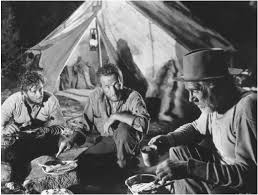 Within California’s workforce world over the past few years, there is growing interest in training certifications, and more recently in training badges. Both certifications and badges are seen as improving the transition of unemployed Californians into jobs. But do they do so, or are they mainly income generators for training institutes?
Within California’s workforce world over the past few years, there is growing interest in training certifications, and more recently in training badges. Both certifications and badges are seen as improving the transition of unemployed Californians into jobs. But do they do so, or are they mainly income generators for training institutes?
Our friends from Treasure of the Sierra Madre (above) know a few things about badges (here). Even they, though, would be hard-pressed to sort through the claims being made about certifications and badges: which, if any, have value in the hiring process. Let’s see if we can start the process, with the assistance of John Colborn of the Aspen Institute and Kris Stadelman of NOVA.
The California community colleges, at the Chancellor’s Office level and among individual colleges, have been taking the lead, actively studying the certification and badge system. A recent mapping effort by the Sector Navigators staff among the Colleges detailed the growing number of certifications. In Advanced Manufacturing, for example, the mapping effort found over 170 certifications being issued by independent entities, including 80 separate certifications by the National Center for Construction Education & Research, 52 certifications by the National Institute of Metalworking Skills, and 17 certifications by the American Society for Quality.
Beyond the certifications is the growth of “stackable certifications”. The idea behind stackable certifications is that a worker can gain certifications in several specialties to expand job options. Los Angeles Trade Technical College has been active in mapping stackable certifications, in such fields as health care and renewable energy. In its Renewable Energy Technician pathway, for example, the College has seven stackable certificate/degree programs, including Solar Thermal Installation and Maintenance Certificate, Weatherization and Energy Efficiency Certificate, and Energy Systems Technology Fundamentals Certificate.
A recent training trend has been the growth of training badges, to indicate skills obtained in non-traditional learning venues. The Mozilla Foundation has developed its Mozilla Open Badges to recognize lifelong learning. The Khan Academy has established a badge system to recognize skills displayed or coursework completed.
The Massive Open Online Courses (MOOCs) of Coursera, Udacity and edX are adding to the certifications and badges. Coursera, for example, offers course certifications in Java Programming, Bid Data, and Web Development, to name a few of the tens of course certifications now available.
What to make of these trends? Three points might be made in terms of our local and state workforce programs.
First, on a collective level, a system of certifications and badges can help in the professionalization of jobs that do not require college or advanced degrees—increasing the sense of craft in these jobs. This is so especially with jobs in the practical economy (non-knowledge economy).
Second, for the individual worker, certifications or badges can increase employability, though in most cases today, the increase will not be by much, if any. Currently most job listings for, say, solar installer or weatherization technician, do not require a certification, and employers are willing to teach specific installation and weatherization techniques on the job. At the same time, for these jobs the certification/badge can serve as a signal to employers of seriousness in the field and ability to achieve a goal. This is similar to the role of the college degree: not really connected to skills utilized in jobs today, but a sorting tool used by employers for hiring decisions.
Kris Stadelman , director of the NOVA WIB, notes that “badges can be an important addition to workforce development. But while the lack of ‘soft skills’ comes up over and over again in every survey we have done of employers, badges have yet to be widely accepted as demonstrating skills competencies by the employer community. It is imperative that they help us solve this issues that they themselves constantly bemoan.”
Third, a main concern for the workforce system is that the system of certifications/badges takes on a life of its own, that funding is put into more and more elaborate systems of credentialing. This is already beginning to take place, with the federal government and private foundations investing in consultant studies and endless meetings on “system building”. A greater superstructure of credentials and system-building, divorced from specific training, is exactly what is not needed.
John Colborn of the Aspen Institute touches on a number of these points in a thoughtful recent commentary on certifications and badges in the workforce system. Colborn writes that “Certificates of various sorts are the fastest growing programs in higher education. And badges seem to offer a clearer playing field where such things as competency-based approaches (rather than classroom time) can take hold.” However Colborn cautions that “a lot of badges start from a flawed skills/abilities needs analysis—asking employers what someone (in theory) needs to know, rather than starting from a market perspective and asking what mix of skills, abilities and experiences actually get people hired.”
The practical, non-theoretical protagonists of Treasure of the Sierra Madre would certainly agree with John on this.

